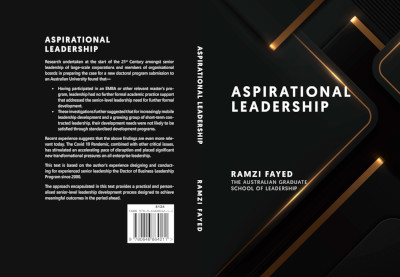Publications
& Papers
Recent BOOK
Aspirational Leadership:
A Personalised Approach to Making the Future Happen Meaningfully.

Add Your Tooltip Text Here
Fayed, R., Aspirational Leadership, AGSL, Sydney 2022
The approach encapsulated in this text provides a practical and personalised senior level leadership development process designed to achieve meaningful outcomes in the period ahead. It is based on the author’s experience designing and conducting for experienced senior leadership the Doctor of Business Leadership Program since 2000. An excellent resource for those who want to be better leaders and make a positive and meaningful difference in the world.
View the book’s Table of Contents.
AU$124.00 (plus postage). Contact us to order a copy.
Working Papers
click the title of a paper for access
This paper presents a justified philosophical and methodological approach to conducting research in business leadership, emphasising pragmatic constructivism as the most suitable research paradigm. It argues that in today’s dynamic and complex business environments, traditional positivist and empiricist approaches—based on objective, deterministic worldviews—are inadequate for understanding the fluid and multi-perspective nature of leadership challenges.
Instead, the authors advocate for a paradigm grounded in constructive realism, which recognises that reality is perceived through the subjective lenses of individuals and is shaped through dialogue, reflection, and shared meaning-making. This approach values multiple perspectives, scepticism, and the contextual, provisional nature of knowledge.
Two research methods are proposed to support this paradigm:
- Participatory Action Research (PAR): A collaborative process where leadership teams co-identify issues and co-create resolution strategies through structured dialogue and clustering of related challenges.
- Aspirational Action Research (AAR): A more autonomous process based on pre-agreed core values, preferred leadership behaviours, and organisational purpose, using iterative testing and reflection to refine strategy and action.
Both methods prioritise actionable outcomes over theoretical generalisations and embrace short-term planning cycles responsive to ongoing disruption.
The proposed research approach is underpinned by:
- Ontology: Reality is constructed through shared perspectives.
- Epistemology: Knowledge emerges from reflective, iterative action.
- Axiology: Leadership values drive all research and action.
The authors acknowledge limitations, including low generalisability and potential for confirmation bias, but justify these as acceptable trade-offs for achieving timely, short-term context-specific action.
A January 2017 Google search for the term ‘leadership’ yielded about 787,000,000 results. Even allowing for duplication, this reflects the enormous volume of material that has been written about leadership, including many bestselling leadership biographies and autobiographies by and of leaders that have been broadly perceived as successful at least at the time of publication. A sample of such “How I or, he did it” literature could include; Bill Gates, Henry Ford, Steven Spielberg, Sir Richard Branson, Steve Jobs, Donald Trump, Sam Walton, Michael Dell, Andrew Carnegie, George Soros, Walt Disney and many others.
“Literally thousands of empirical investigations of leaders have been conducted in the last seventy-five years alone, but no clear and unequivocal understanding exists as to what distinguishes leaders from non-leaders, and perhaps more important, what distinguishes effective leaders from ineffective leaders.” In 2007 Vroom and Jago claimed that “Although this assertion is over 20 years old, our position is that any serious review of the more recent literature would reveal that the quote is as relevant today as it was then.”
As yet there is no generally accepted definition of leadership and only a wide variety of generic guidance as to appropriate leadership action therefore, each leadership practitioner must develop and continuously update a personal contingent view of what leadership means to them given their context. We propose a number of generic approches from which a starting point that might assist could be selected.
In complex dynamic environments, leadership will need to continuously re-assess the net value derived by each key stakeholder from the exchanging value with the organisation given the risks and costs borne by each party to the exchanges. In turbulent contexts this requires the support of automation and artificial intelligence and organisation are now emerging to provide such services.
“According to a recent Fortune survey, only 7 percent of CEOs believe their companies are building effective global leaders, and just 10 percent said that their leadership-development initiatives have a clear business impact. Our latest research has a similar message: only 11 percent of more than 500 executives we polled around the globe strongly agreed with the statement that their leadership-development interventions achieve and sustain the desired results.”
The clear majority of pre-existing work in the published domain of competitive bidding requires large sample sizes for reliable econometric, probabilistic or game-theoretic modelling techniques. Such unrealistic large data requirements have prevented the successful application of bid modelling in managerial practice. This article presents a new predictive analytics method for very small samples of historical bidding data. Requiring as few as nine competitive bid prices for a group of pooled/aggregated competitors over a 30-month period is the standout differentiator of this research from any previously published research. This minimizes the demands on competitive intelligence and, therefore, realistically enables its application in the real world of practice. Maximum likelihood estimations are used to evaluate two new, revolutionary bid strategies against a range of evaluation criteria, taking into account the pricing judgements made by competitors, including a degree of competitive reaction among them. Using off-the-shelf analytics software, a case study of a bidder from the telecommunications infrastructure sector demonstrates how commercial outcomes can be improved substantially: A 400 per cent improvement in win ratio, an 86 per cent increase in contribution margin and 76 per cent revenue growth. In addition, the difference between the submitted bids and the lowest-priced competing bids (which is an opportunity cost, sometimes referred to as the ‘spread’ or ‘money left on the table’), has been reduced to 2 per cent on a total revenue of US$210 million.